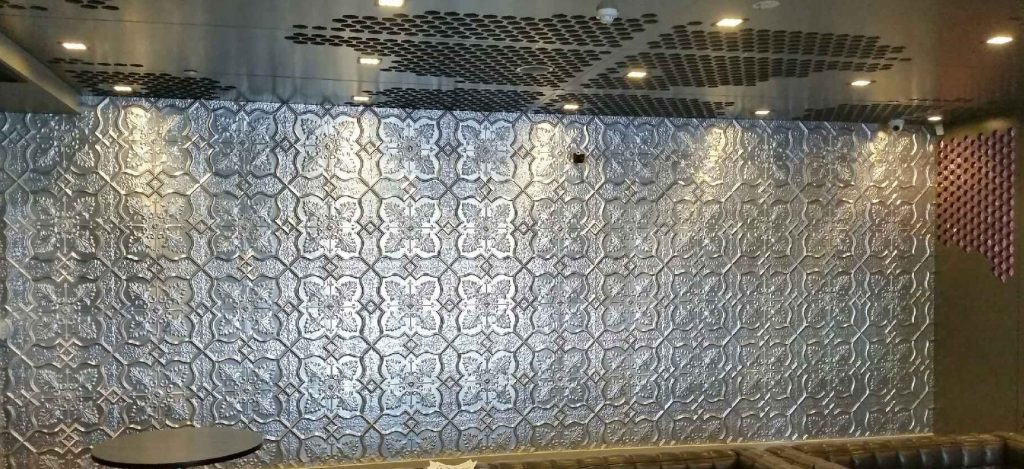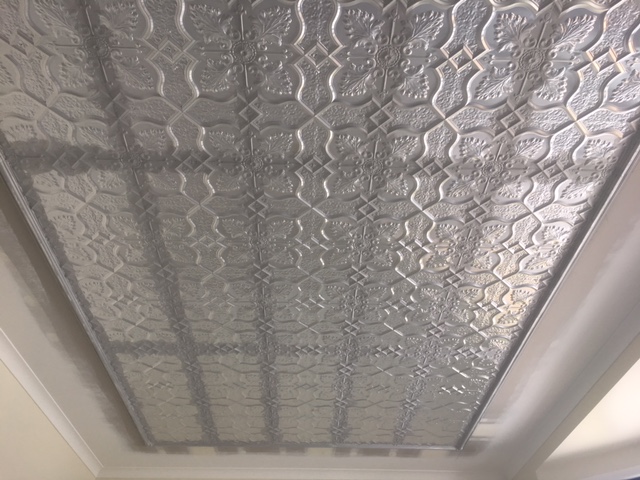Pressed metal make a great option for a feature wall. The panels are large – 1830mm long and either 610 or 915mm high. You cut them to fit (see below) and then glue them to the wall with Soudal High Tack Fix All Adhesive. You can use aluminium or timber trim to edge the panels if you just want to do a section of a wall.
WHAT ARE THE PANELS MADE OF?
The panels are made in Australia by Pressed Tin Panels from 0.55mm mill grade Aluminium sheets, they will not rust and are suitable for both interior and exterior use. Although the panels are only 0.55mm thick they do become quite rigid once the pressing process occurs.
HOW MANY PANELS WILL YOU NEED?
Bring in, text or email us a plan of your area. Don’t stress, the plan can just be a quick hand-drawn sketch. Period Details staff just need to see the area with measurements. From this they will calculate the number of panels you require and advise on suitable trims for finishing off exposed edges. With over 30 years’ experience in supplying and installing Pressed Tin Panels our staff can provide you with design ideas and the most economical layout.
RAW, PAINTED OR POWDERCOATED
In the raw (silver) finish surface scratches and discolouration will be present. This is part of the manufacturing process. Once the panels are pressed they are dipped in a chemical bath – non-chromate solution. This solution makes them ready to polish, paint or powdercoat.
If you are after an Industrial vibe, you can leave the panels raw. If leaving in the “raw” aluminium finish. You can leave as is or use a metal polish such as “metasol” or “autosol” to polish out to a Chrome like finish.
If you are after a painted finish then the panels can be powdercoated, sprayed, brushed or rolled to achieve the desired coverage.
For a feature wall it’s easier to install the panels when they are raw and to paint them once installation is complete. This also provides you with the flexibility to update your colour scheme later on. As the panels are not porous they are really easy to paint. Apply an “All in One” Primer/Sealer/Undercoat e.g. Dulux 1 step and then top coat.
Panels can be powdercoated prior to installation but it will make the fitting process longer and is not recommended for high profile patterns such as Shield.
Powdercoated ‘Pressed Tin Panels’ are easy to keep clean with warm soapy water or warm water and Methylated Spirits. Use with a soft ‘lint free’ cloth or a Micro-fibre cloth. Simply wipe over the area regularly and it will look great for years to come.
Please note: Detergents that recommend the use of gloves when handling must not be used as this is a good indication that the detergent is harsh and therefore, unsuitable for cleaning powder coated pressed metal surface.
FEATURE WALL: INSTALLATION INSTRUCTIONS (Shield Pattern)
BEFORE YOU BEGIN: WE SUGGEST THAT YOU READ THROUGH THE INSTRUCTIONS
Tools that may be required:
- Tape Measure and a Builders Pencil.
- Straight Edge
- Stanley Knife and spare blades for the Stanley Knife
- Tin Snips – curved (right and left handed)
- Angle Grinder with aluminium cutting disc
- Drill and Hole Saw, Tin Snips and Pliers for cutting GPO holes
- Soft Cloth
- Soudal Fix All High Tack Glue – 1 tube per panel for 915 mm sheets and 2 tubes per every 3 610mm panels. Add 1 extra tube per 5 of the 610mm panels.
- No More Gaps
- Drop Saw for cutting the Wallboard cappping, timber or 10mm aluminium trim
CAUTION SHOULD BE USED AT ALL TIMES AS METAL EDGES CAN BE VERY SHARP.
- Power Points: for your safety it is best to have an electrician disconnect the power points.
STEP 1: WIPE DOWN THE WALL
- Ensure the wall surface is smooth and clean from any loose debris and dust. Wipe over with a damp soft ‘lint free’ cloth.
STEP 2: MEASURING AND LAYING OUT THE PATTERN
- Measure the wall where the panels will be installed.
- Determine how you will set out the pattern.
Ask yourself these questions:
- Which direction will you have the overlap in?
- Which is the prominent way you look at the wall?
- Where is the light source?
- Remember all panels are pressed to allow a 7mm (approximately) overlap join on every edge.
Don’t forget that the patterns are directional:
- Our ‘Pressed Tin Panels’ have a sticker on the back showing the direction in which they have come off the press – make sure that these stickers all run the same way – this will provide you with much neater overlaps.


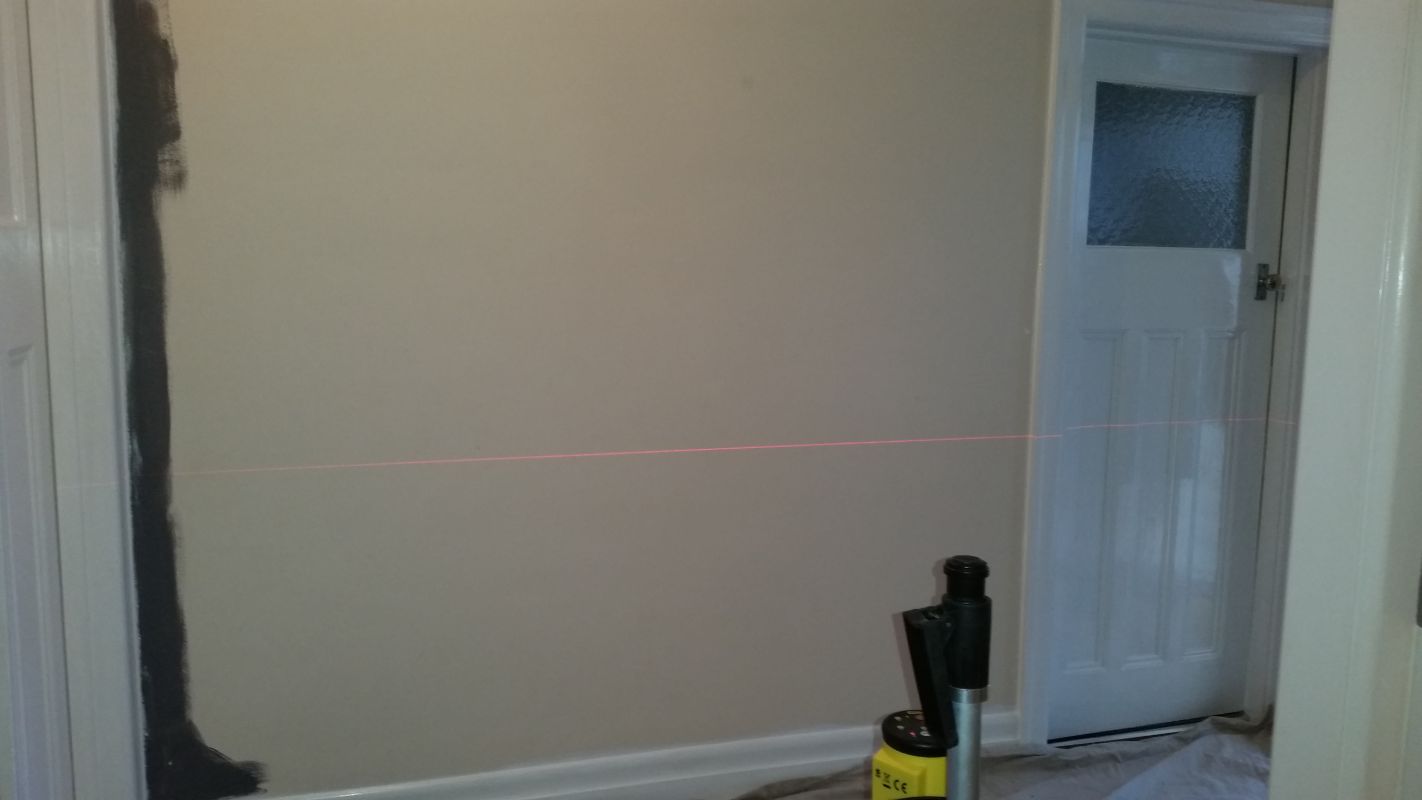

STEP 3: CUTTING THE PANELS
Measure and cut the first panel.
- Lay the panel face down (sticker is on the back) on a stable work table.
- Measure and scribe the panel where it is to be cut.
- As the Shield panel has a deep profile you will need to use a grinder to cut it.
- If it was a lower profile you could use a Stanley knife to scribe (4-5 times) then rock and snap.
- Remove the burr from the cut edges with a file or the edge of the Stanley knife.




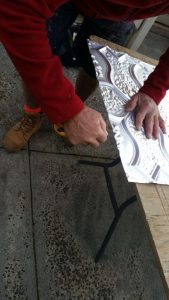

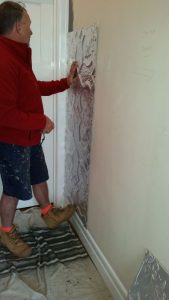

Adhere the first panel
- Starting in a corner, cover the back of the sheet with ‘Soudal Fix All High Tack’ on the flat surfaces.
- Be generous. Use 2/3rds to a whole tube.
- Run a bead of ‘Soudal Fix All High Tack’ down the wall approximately 25mm in from each end.
- Place the panel on the wall into position.
- Rub over with a soft cloth (Tip: Remove all jewellery) to ensure a bond between the metal and the wall.
- Press the Shield panel onto the wall to create a bond between it and the wall.
Second and subsequent panels.
- Measure where the next panel is to be installed (remember to allow for overlaps)
- Cut and fit the next panel.
- Change the overlap/underlap as you go to minimise the appearance of where panels meet together.
- Scroll down to see details on cutting out GPO’s (power points).
- Adhere to the wall as per above.
- You can use a small rivet to pull the panels together at the overlap/underlap point and use a small rivet to pull the corners of the 4 panels together where they meet.
- Another trick to minimise the joins is to tap along the joins with a piece of timber.
- You can then point up the joins with “no more gaps”.
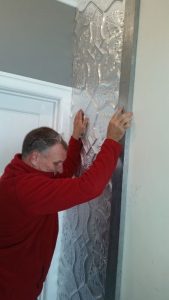





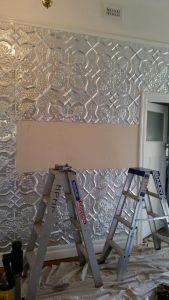



Minimise the appearance of the overlaps/underlaps with “No More Gaps”. Image is of a ceiling.
The Finished Wall
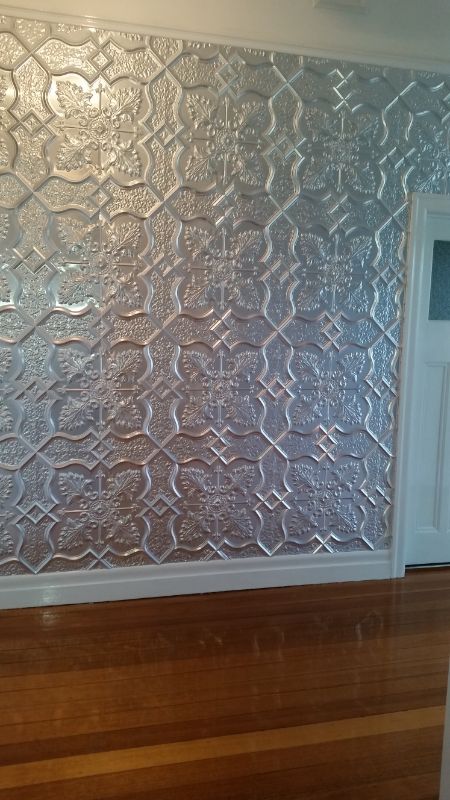

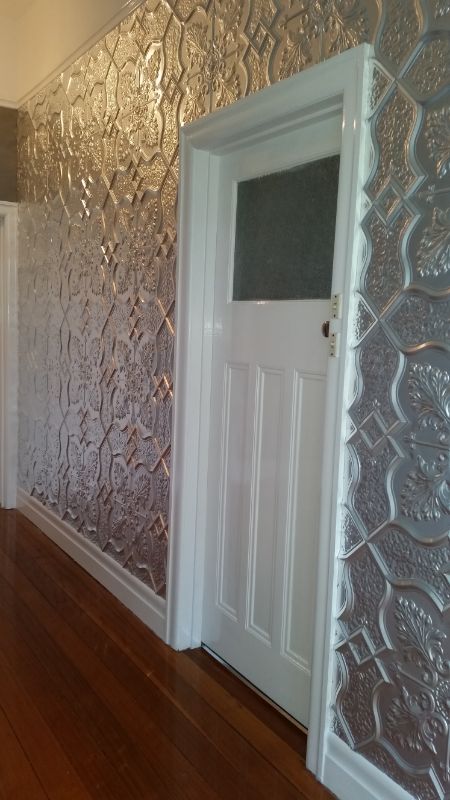

Power Points (Shown on Lattice pattern):
- Mark the position of the power point on the back of the panel.
- Using a straight edge scribe a 90 x 55mm rectangle.
- Scribe diagonally to each corner.
- Drill a hole in the centre point with the hole saw.
- Use the tin snips to cut along the diagonal scribed lines to the outer corners.
- The metal can then be rocked back and forth and it will snap at the outside scribe lines.
THERE ARE MANY MORE PATTERNS THAT YOU CAN USE TO MAKE A PRESSED METAL FEATURE WALL
Chat to our sales staff to determine the best pattern and finish for your feature wall.
Continuous patterns work well on a feature wall but really any of the patterns can be used.
Some suggested designs are:
- Art Deco – Pressed Metal Panel – (6ft x 3ft)
- Beresford – Pressed Metal Panel – (6ft x 2ft)
- Brick – Pressed Metal Panel – (6ft x 3ft)
- Carnivale – Pressed Metal Panel – (6ft x 2ft / 6ft x 3ft)
- Carousel – Pressed Metal Panel – (6ft x 3ft)
- Clover – Pressed Metal Panel – (6ft x 2ft / 6ft x 3ft)
- Evans – Pressed Metal Panel – (6ft x 2ft / 6ft x 3ft)
- Large Maple – Pressed Metal Panel – (6ft x 2ft / 6ft x 3ft)
- Lily – Pressed Metal Panel – (6ft x 2ft / 6ft x 3ft)
- Lizards – Pressed Metal Panel – (6ft x 2ft / 6ft x 3ft)
- Maze – Pressed Metal Panel – (6ft x 3ft)
- Melbourne – Pressed Metal Panel – (6ft x 2ft / 6ft x 3ft)
- Mudgee – Pressed Metal Panel – (6ft x 2ft / 6ft x 3ft)
- Original – Pressed Metal Panel – (6ft x 2ft / 6ft x 3ft)
- Posy – Pressed Metal Panel – (6ft x 2ft / 6ft x 3ft)
- Shield – Pressed Metal Panel – (6ft x 2ft)
- Snowflakes – Pressed Metal Panel – (6ft x 3ft)
- Spades – Pressed Metal Panel – (6ft x 2ft / 6ft x 3ft)
All instructions are given as a guide only. We hold no responsibility for the incorrect installation or use of our products.
NEED FURTHER ASSISTANCE?
Visit our showroom (Trade Only During Stage 4 Lockdown):
Open Monday to Friday 10am to 4pm.
Phone our showroom:
Phone: 03 9729 1498 or 0405 460 997
Phone our installer:
David Peake on 0418 342 930 (10am-4pm Monday to Friday). Send him a text asking him to call you back if he doesn’t answer.

